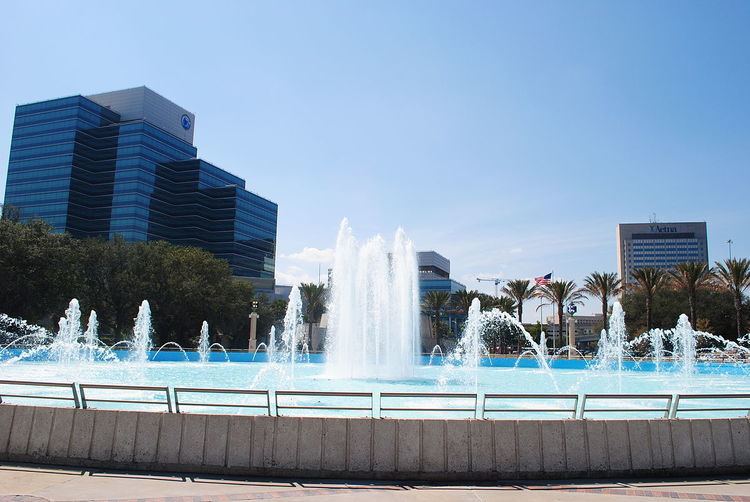 | ||
Address 1015 Museum Cir, Jacksonville, FL 32207, USA Hours Open today · 6AM–10PMFriday6AM–10PMSaturday6AM–10PMSunday6AM–10PMMonday6AM–10PMTuesday6AM–10PMWednesday6AM–10PMThursday6AM–10PM Similar Kingsley Plantation, Little Talbot Island State Park, Hanna Park, Museum of Science and History, Jacksonville Landing | ||
Minecraft xbox cave den friendship fountain 18
Friendship Fountain is a large fountain in Jacksonville, Florida. It is located in St. Johns River Park (also known as Friendship Fountain Park) at the west end of Downtown Jacksonville's Southbank Riverwalk attraction. The world's largest and tallest fountain when it opened, it has been one of Jacksonville's most recognizable and popular attractions.
Contents
- Minecraft xbox cave den friendship fountain 18
- History
- Harbormasters and River City Brewing Company
- Long service
- Features
- Current status
- References
The fountain and park were designed by Jacksonville architect Taylor Hardwick in 1963 and opened in 1965. The fountain's three pumps could push 17,000 US gallons (64,000 L) of water per minute up to 100 feet (30 m) in height. Friendship Fountain remained one of Jacksonville's signature attractions through the 20th century, but severe corrosion and deterioration to the equipment resulted in periodic closures in the 2000s. In 2011 the city completed a $3.2 million renovation to the fountain and the surrounding park.
History
The fountain and Friendship Park was designed by Taylor Hardwick, the Jacksonville architect who also designed the Haydon Burns Library. An area of 14 acres (57,000 m2) of land were donated for the project by the Southside Business Men's Club, an organization dedicated to the improvement of the Southside that was established in 1932. Begun in 1963 and completed at a cost of $1.7 million, the park opened in March 1965. The "world’s largest and tallest" fountain at the time, it became a popular tourist attraction.
The three pumps had a combined 750 horsepower (560 kW) and could push 17,000 US gallons (64,000 L) per minute; some streams as tall as a 10-story building. The enclosure for the pumps and controls was so large that the architect had to include it as an element of design.
The Fountain was originally called the "Fountain of Friendship in Dallas Thomas Park"; friendship at the suggestion of a Rotary Club member and Dallas Thomas after the city's parks and finance commissioner. However, when Thomas was later involved in a scandal and indicted, the park was renamed in 1968.
Harbormasters and River City Brewing Company
The Acosta Bridge was rebuilt beginning in 1990, and the Diamond Head Lobster House was in its path and had to be demolished. The city agreed to use a big portion of Friendship park for the new restaurant and parking lot, cutting the park by more than half. Essentially, all the design structures in the park were removed-—with the exception of the fountain itself—-for what became a boondoggle. The new facility was named Harbormasters, and the city guaranteed a $2.9 million federal building loan on the city's land. Initial success was followed by lawsuits, a new owner, missed rent payments, foreclosure, loan default and finally closure in 1992. When the venture failed, the city had to pay off the nearly $3 million loan. The River City Brewing Company, which replaced Harbormasters in November 1993, has been successful, but because the city owns the land, the restaurant pays no property taxes.
Long service
Friendship Fountain functioned for over 20 years and was refurbished in December 1985, before resuming operation for another 15 years. Finally, wear and corrosion forced its closure at the end of the century. A five-month, $1.3 million rehabilitation began when the fountain was drained in March 2001. A new feature was added: six light towers with computer-controlled color-changing floodlights. Unanticipated damage to stainless steel pipes was uncovered, requiring a $97,000 increase in cost and two-month delay, but the fountain re-opened in December 2001. It operated for seven months until a power outage/voltage spike damaged the computer controller and blew out 40 lights and lenses on April 29, 2002. That was repaired, and the fountain was fully functional for nearly 3 years. It was a major attraction at Super Bowl XXXIX in February 2005, but two months later, two of the three original (40-year-old) pumps failed and parts were no longer available. The replacement cost for the pumps was estimated at $400,000, but the city budget was tight and money was not available. Afterward the fountain was run on one pump with a greatly reduced flow. It was repaired in 2011 and is functional.
Features
Current status
The future of the Jacksonville landmark was in doubt for a number of years. A number of proposals were made, including moving Kids Kampus from Metropolitan Park and eliminating the fountain, rebuilding a smaller fountain or renovating the existing fountain. As of May 2008, there was $15 million in the city's capital projects budget to improve the Southbank Riverwalk, which includes the area around Friendship Fountain; but Mayor John Peyton felt the amount was not enough.
The Jacksonville City Council approved final plans for a $3.2 million renovation and repair to the surrounding park and Friendship Fountain on February 9, 2010. On August 10, 2010 [1], The Friends of Friendship Fountain Website, reported communications from the Jacksonville Economic Development Commission that AC General Inc was named contractor for the project. An official groundbreaking was held on September 1, 2010 marking the start of the renovation of Friendship Fountain and Park. The fountain was closed for eight months for construction, and reopened again on June 18, 2011 amid a celebration.
